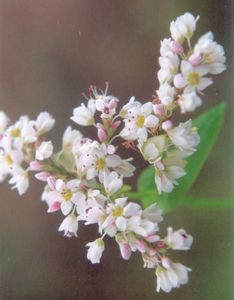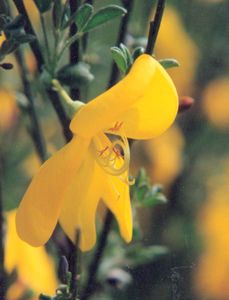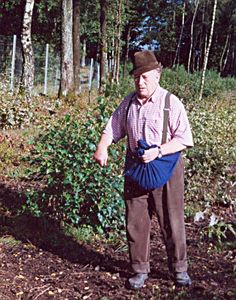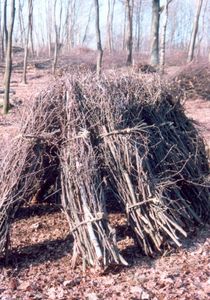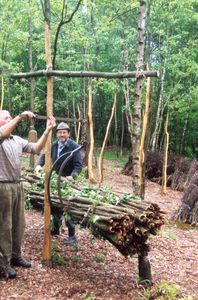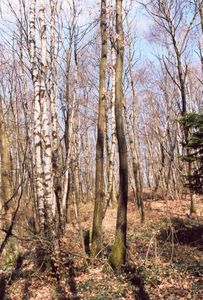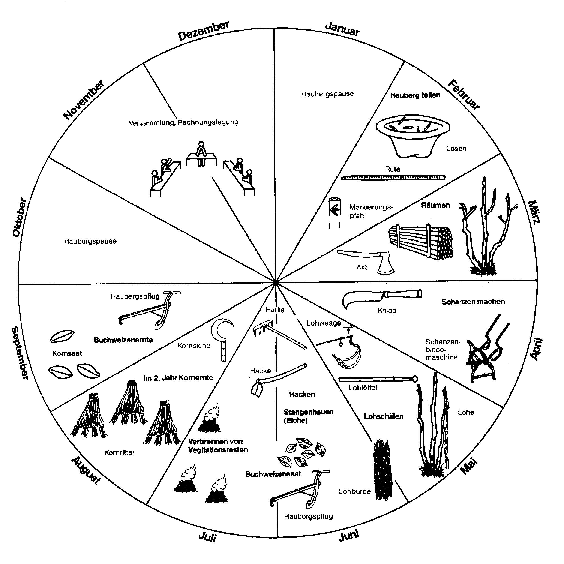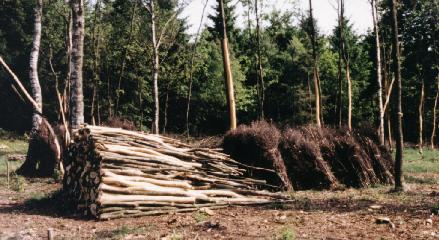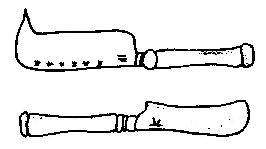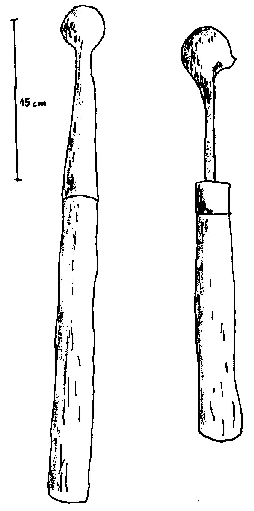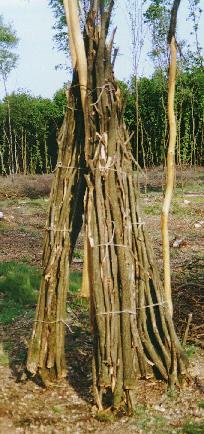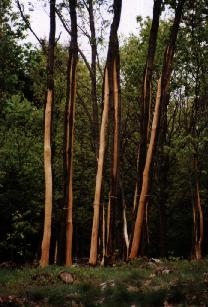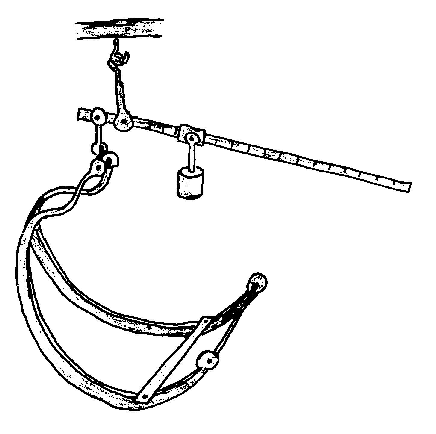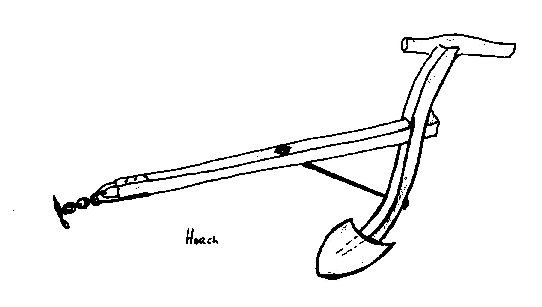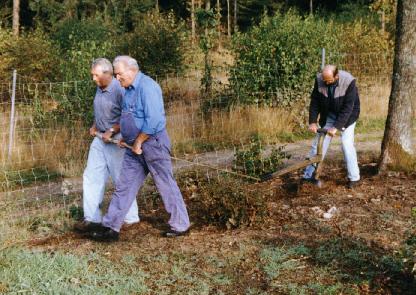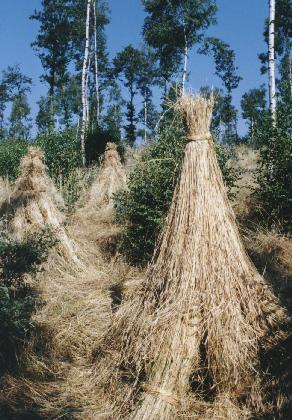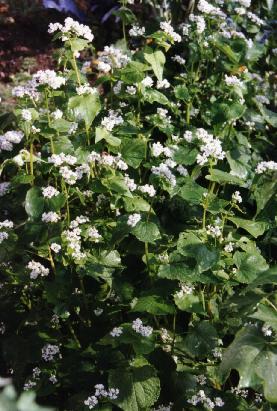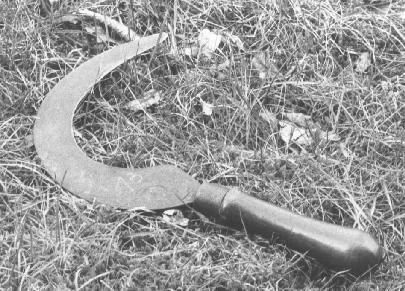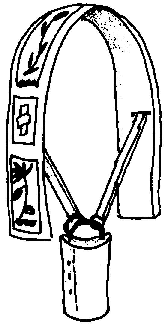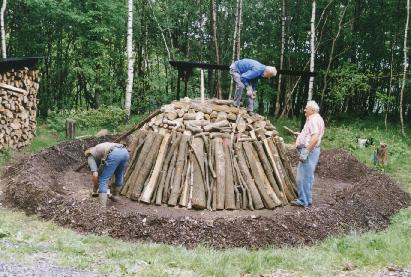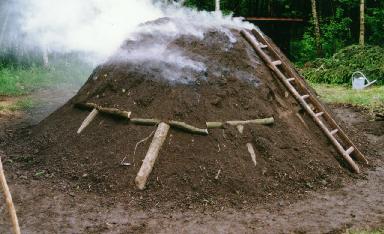Contents
- Partition
- Clearing
- Making Brushwood Bundles
- Bark Peeling
- Hewing Down
- Hacking and Burning
- Sowing
- Rye Harvest
- Wood Pasture
- Charcoal Burning
- Hauberg Assembly
1. Partition
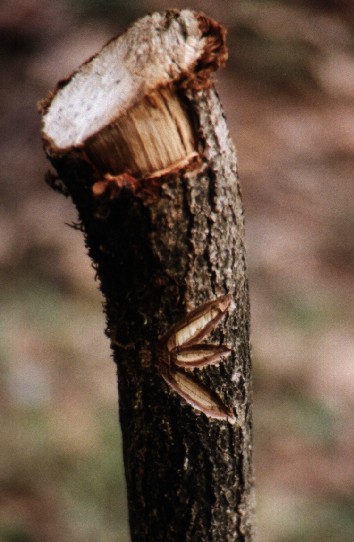
Each year the then oldest partial area (cutting area) is worked on by all shareholders together. The hauberg is divided into as many cutting areas as correponds to the number of years (usually 16-20) in the turnover period of the respective hauberg.
The shareholders must be able to participatein the work on the annual cutting area corresponding to their respective shares. To that end, the cutting area (Schlag) has to be divided into stripes (Jähne) of different sizes. The so called small partioning is done using a hauberg rod, a versatile wooden rod or beam which has a separate scale on each side for each shareholder allowing to measure the assigned stripe width directly without any additional calculation. This is done under the observation of the hauberg board after the order of sequence of the shareholders has been drawn from a lot, in order to avoid arbitrary benefits of single shareholders by assignation of especially properous partial areas.
When the width of the stripes (Jahnbreite) has been determined and the order of Jahns is been established, so have the borders between them. THey are now marked for the duration of the stripe by using wooden pegs, so called Stifte (also Stibbe). These pegs consists of oak wood sticks about an arm's width of about 70cm length on whose upper part the hauberg signs of the adjacent Jahns are carved. Hauberg signs are unchangeable markers of individual shareholders which must not be used by third parties in the same hauberg collective and may be used the the authorized shareholder also for marking his own devices and tools.
2. Clearing
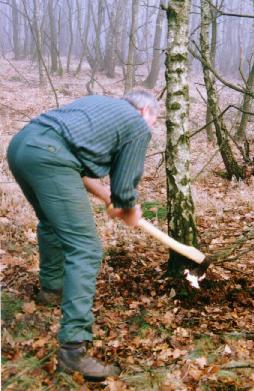 Imediately after the division, the share holders start - each on his hown assigned strip - to cut down the softwoods, i.e. birches, rowans, and willows, as well as the oaks that cannot be peeled. Oaks to be peeled as well as a few exceptionally well grown birches are left standing, the latter as seed trees.
Imediately after the division, the share holders start - each on his hown assigned strip - to cut down the softwoods, i.e. birches, rowans, and willows, as well as the oaks that cannot be peeled. Oaks to be peeled as well as a few exceptionally well grown birches are left standing, the latter as seed trees.
In former times, the cutting was allowed only with sharp axes be cause the belief prevailed that the ability to sprout would suffer if saws were used. Noadays, the softwoods are mostly cut down with chain saws, without any obviuos disadvantage for the trunk sprouts.
3. Making Brushwood Bundles
The branches are cut from the hewn trees (debranched, 'geschneiselt') mostly with the 'Knipp', a kind of bush knife with a sharp blade curved at the tip and a wooden handle.
The remaining wooden poles are gathered with a hauberg sleigh or by simply dragging and piled near the next path. In former times they were used for charcoal burning, today mostly for as firewood.
The accumulated branch and treetop brushwood is bound into 'Schanzen'; these are brushwood bundles of about 1 m length and 30cm diameter, which are held together by a 'Wed', i.e. a twisted willow or brich branch, twice, at the front and back end (see photo above).
The bound bundles are gathered near the paths using a 'Schuffbock' (hand barrow), set up in roof form for drying, and today as in the past used for heating stone stoves, in which brad loaves of rhye flower, milk, and sourdough are baked to spicy "Schanzenbrot".
4. Bark Peeling
Oak bark, especially the mirror bark of young oaks, contains 10-11% pure tanning agent and therefore is suitable for tanning animal hides to high grade and sturdy leather.
The oak bark ('Lohe') is obtained from standing trunks by decorticating the trees at the time of foliation using a special tool, a bark spoon ('Lohlöffel' or 'Schöwwel') up to a hieght of 4-5m, and letting the bark tube hang for some days to dry and tear them of therafter to weigh them and sell them to a tanner or bark mill.
5. Cutting Down
The barked oak staves are as soon as possible after taking down the bark, like the softer woods a few weeks before, hewn or cut directly above the soil.These barked staves originally, like the softer woods, were used exclusively for burning coal, nowadays for burning, with the exception of crafting rustic looking garden furniture.
Die Schälstangen wurden ursprünglich wie die Weichholzstangen ausschließlich zur Verkohlung verwendet, heute entsprechend zum Verbrennen, ausnahmsweise zur Herstellung rustikaler Gartenmöbel. The brushwood of the oaks is also bundled into Schanzen.
6. Hoeing and Burning
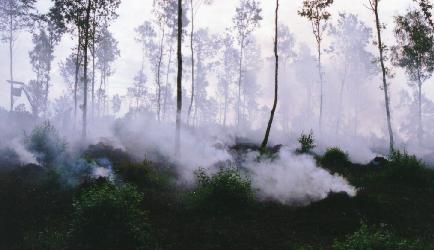 After removing the bark, in preparation for the intermediate agricultural use, the ground cover of grasses, herbs, and shrubbery is peeled with a Hainhacke (grove hoe). The resulting grass sods are then dried until the attached earth can be removed by pounding (sod pounding). the remaining organic rests are collected in small heaps and burned. (sod burning). The resulting ash is distributed the following day over the complete hewn area.
After removing the bark, in preparation for the intermediate agricultural use, the ground cover of grasses, herbs, and shrubbery is peeled with a Hainhacke (grove hoe). The resulting grass sods are then dried until the attached earth can be removed by pounding (sod pounding). the remaining organic rests are collected in small heaps and burned. (sod burning). The resulting ash is distributed the following day over the complete hewn area.
7. Sowing
The area prepared by hoeing and burning is sowed either in June with buckwheat (Fagopyrum esculentum, a smartweed family), or in September with winter rye and the seed plowed under and covered with earth with a hooked plough (Hoach, see right side). Buckwheat ripens in October of the seeding year, winter rye in August of the following year.
8. Harvest
When ripe, buckwheat ("Haidloff") and rye (Corn) are cut with a sickle (Gräser), tied into sheaves and (at least the sheaves of the grain) assembled into grain knights (Fig. above) until they are thresh-dry and can be brought in to to be threshed on cloths in the Hauberg or on the farm threshing floor in winter.
The use of scythes to harvest grain in the Hauberg used to be forbidden because it could all too easily damage the young shoots that sprout from the roots of the deciduous trees and form the basis for future wood use.
Rye flour from Hauberg grain makes a particularly tasty brown bread. Buckwheat used to be baked into small cakes or used to make porridge. Before the grinding process, however, the buckwheat grains have to be peeled because their seed coat contains bitter substances that can damage the health of humans and livestock.
9. Wood Pasture
Not only the shareholders, but all villagers were previously allowed to graze as many animals (usually only cattle, occasionally sheep) in the Hauberg during the summer as they could feed from their own fodder supplies in the winter. Goats were banned from grazing because of their harmful effect on the forest. Also excluded were mountainous areas that were less than 5 to 7 years old because the cattle would have bitten the top of the buds on them.
The forest grazing was done under the supervision of a shepherd employed by the community, who was paid for this and sat at tables of the houses involved. To facilitate supervision, the herd animals wore well-tuned bells (Schellen) on artistically carved and painted wooden hangers around their necks.
Around the turn of the 19th to the 20th century, it was recognized that forest grazing was predominantly disadvantageous for the forest and at the same time insufficient for feeding the cattle breeds, which had meanwhile become more efficient and demanding through breeding. The pasture rights were therefore replaced by clearing parts of the Hauberg, which were converted into efficient pasture campaigns through tillage and fertilization and from then on made available to the pasture entitled as summer pasture.
10. Köhlerei
Zur Verhüttung des im Siegerland früher reichlich geförderten Eisenerzes wurde vor der Verfügbarkeit von Steinkohle in großem Umfang Holzkohle benötigt.
Holzkohle wird bis heute in Meilern hergestellt, die nach folgendem Schema aufgebaut sind: Um den sogenannten Quendelschacht herum ,der entweder ein Kamin aus kreuzweise geschichteten Laubholzstücken oder eine mit Reisig umwickelte, im Zentrum des Meilers aufgestellte Stange ist, werden die zu verkohlenden , ca. 1m langen Holzstücke in einer oder zwei Schichten möglichst dicht zu einem halbkugeligen bis kegelstumpfförmigen Holzhaufen gestapelt. Dieser Rohbau des Meilers wird anschließend mit einem Rauhdach aus Rasensoden oder Fichtenreisig bedeckt und schließlich mit einer Erdschicht (Erddach) möglichst luftdicht abgedeckt.
Das Prinzip des Meilervorganges besteht nämlich darin, durch unvollständige Verbrennung des Holzes bei gedrosselter Luftzufuhr zwar die flüchtigen Bestandteile des Holzes einschl. Wasserdamf zu entfernen, aber die vollständige Verbrennung des Holzes zu Asche zu verhindern. Gleichwohl darf das im Meiler entzündete Feuer auch nicht erlöschen, weil sonst keine Holzkohle entstehen könnte. Deshalb werden in die Außenhaut des Meilers Zuglöcher mit einer Stange eingestoßen, je nach Verkohlungsfortgang erweitert, geschlossen und verlagert,bis der Köhler an der Farbe des Meilerrauches und an der Form des Meilers erkennt, daß die Kohle gar ist. Nach einer Abkühlungsperiode von 2-3 Tagen wird der Meiler nun geöffnet, die noch heiße Holzkohle zur Abkühlung flach ausgebreitet, verwogen und (heute) zu Grillzwecken verkauft. Früher wurde die Holzkohle mit Kohlenwagen zu den Eisenhütten und Hämmern transportiert, vom Zainmeister dort verwogen und nach dem ermittelten Gewicht vergütet.
Die Ausbeute an Holzkohle beträgt durchschnittlich 20% des Gewichtes der eingesetzten Holzmenge.
11. Haubergsversammlung
Zu Beginn des Winters, spätestens im frühen Frühjahr, treffen sich die Anteilseigner des Haubergs unter Leitung ihres meist dreiköpfigen Vorstandes zur Haubergsversammlung. Diese dient der Rechnungslegung des Vorstandes für das abgelaufene Wirtschaftsjahr, der Erstattung von allgemeinen Rechenschaftsberichten durch die Haubergsorgane (Vorsteher, Rechner, Rechnungsprüfer, Schriftführer etc., der Beschlußfassung über die Lage und Aufteilung des nächstjährigen Jahresschlages sowie über weitere Wirtschaftsmaßnahmen, der Beschlußfassung über die Verfassung (Satzung) der Genossenschaft sowie (periodisch) der Wahl der satzungsgemäßen Organe der Genossenschaft.
Das Stimmrecht der Mitglieder der Hauberggenossenschaft (heute: Waldgenossenschaft) in der Haubergsversammlung richtet sich nach der Größe ihrer Haubergsanteile.
Die örtliche Forstbehörde übt die Fach- und Rechtsaufsicht über die Waldgenossenschaft aus und nimmt deshalb nicht selten an den Haubergsversammlungen teil.
Mit der Haubergsversammlung schließt sich der Jahreslauf der Haubergsarbeiten bzw. beginnt ein neuer Jahreszyklus.
